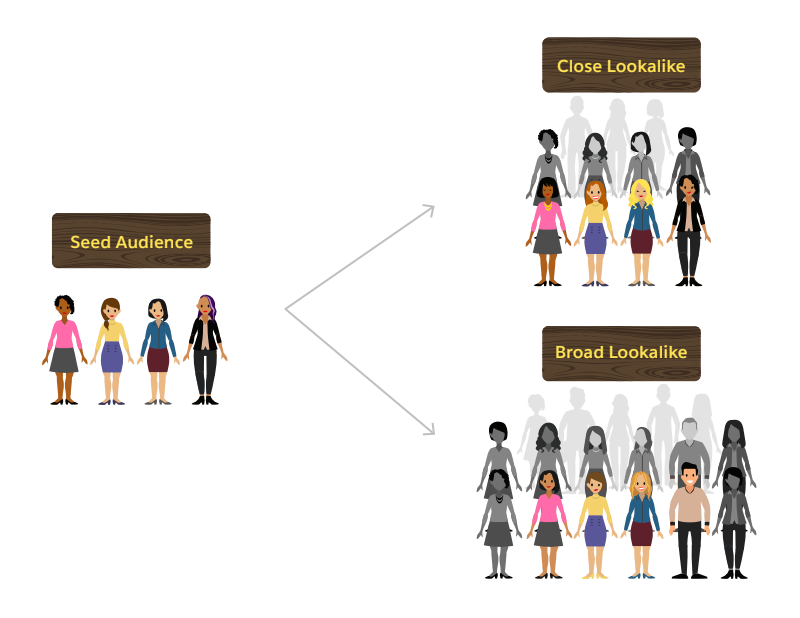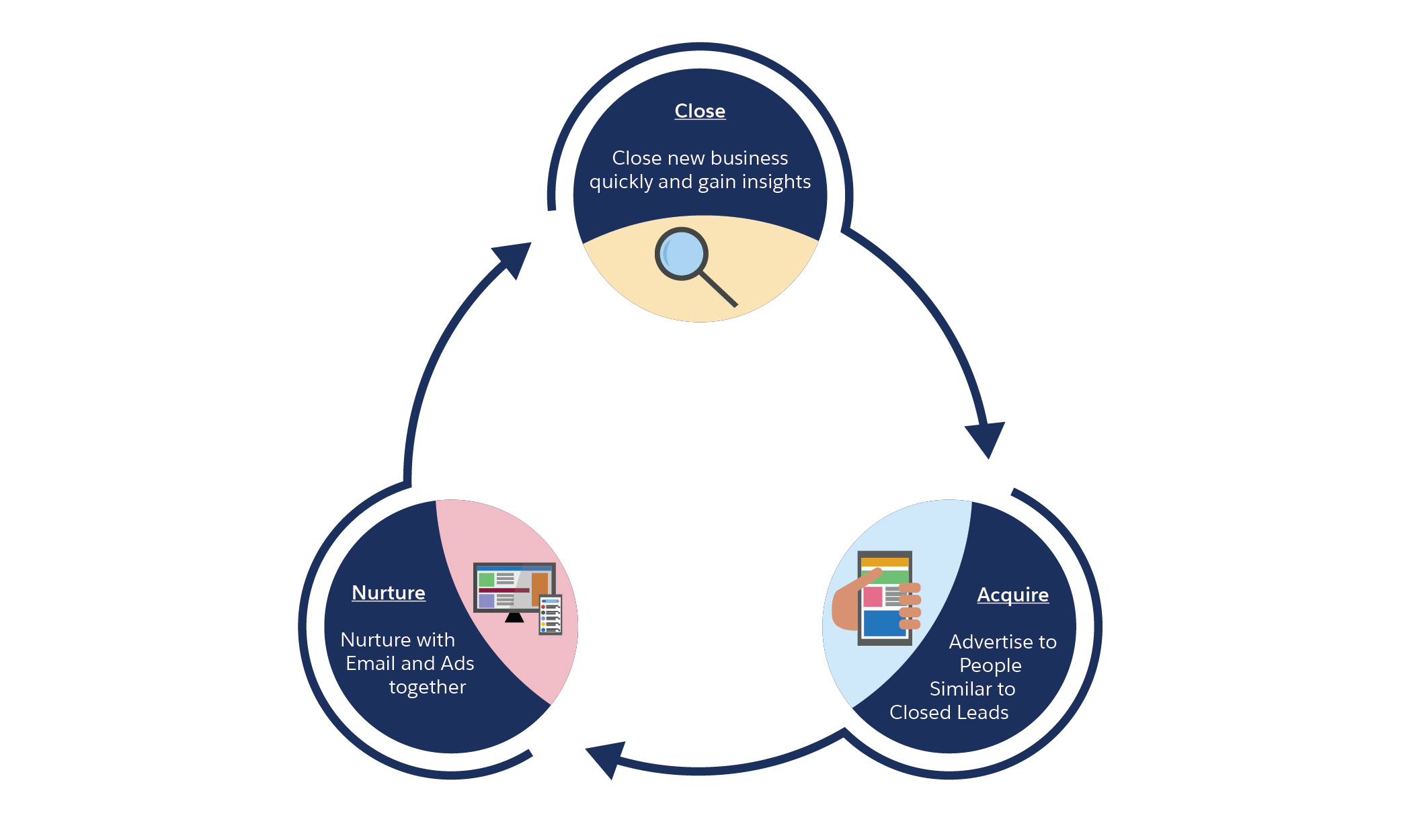Use Your Own Data to Acquire New Customers
Learning Objectives
After completing this unit, you’ll be able to:
- Describe what a lookalike audience is.
- Explain how advertising to lookalike audiences can benefit your company.
- Describe the value of an “always-on” lead-generation machine.
Introduction
Advertising plays a key role throughout the customer lifecycle. But one of its biggest contributions has always been to guide new customers through the original purchase funnel.Of course, you’d love to tell your CMO, “My work this month got us more customers who behave just like our current best customers!” So how do you do that?
Find New Customers with Lookalike Audiences
One great way to bring in new customers is through advertising to lookalike audiences.
Lookalike audiences are just what they sound like—they’re a group of people who behave like another group of people, such as your best customers. You can build them in a number of different platforms. Facebook can automatically build these audiences for you, you can also use Google’s platform (with a feature called Similar Audiences), or you can use Marketing Cloud Engagement Advertising to have Salesforce build lookalike audiences using Einstein-powered models based on your own data.

Marketing Cloud Engagement Advertising
With Marketing Cloud Engagement Advertising, you can use your own first-party customer data to advertise and create lookalike audiences by securely scrambling the data to ensure it stays anonymous, and sending it to platforms such as Facebook or Google. This scrambling is called hashing, and at Salesforce we use an algorithm called SHA-256 to ensure that the data cannot be unscrambled.
Facebook and Google then compare the hashed data with hashes of all of their own customer information. If the two hashes match, then you can advertise to the individual person—all without any customer data leaving the secure environment of Salesforce.
One of the most common acquisition use cases for marketers is growing their email subscriber or prospect bases, in order to eventually convert them to paying customers.
So, let's say you want to get more newsletter subscribers. But you don't want to just get anyone, right? You want to find people who are similar to your best subscribers. To do that, first define what makes a great subscriber. You can look at a variety of factors, including:
- Which newsletters a customer has subscribed to
- Which emails they have opened
- What links they have clicked
- Purchase history, especially for items you show in your emails
Then you can focus your efforts on attracting new audience segments that are similar to your ideal subscribers.
This same concept applies to finding other types of new customers.
By creating lookalike audiences of their best customers, the spirits company Pernod Ricard achieved dramatic results. What stood out most to the company was how well qualified their leads were and how relevant their content was to their target audience. In just 11 weeks they acquired 46,000 net-new leads—three times more than they had expected! What’s more, on their follow up emails, they saw open rates of between 43% and 77%.
“Always-On” Lead Generation
Using lookalike audiences is a great tactic for finding new leads similar to a specific segment of customers. But what’s really compelling is how it can help you turn your acquisition efforts into an “always-on” lead-generation machine with a combination of lookalike audiences and nurturing ads to your prospects.
The humble lead capture form has been B2B marketers’ bread and butter for many years. These forms collect prospect contact information in exchange for specific content such as a webinar or ebook. Of course, all marketers want as many leads as possible to become customers. Yet few marketers describe their lead generation efforts as successful.
Why is that?
Part of the problem is that, for many marketers, advertising is not connected to the rest of the purchase funnel we described at the start of this unit.
It’s therefore difficult for marketers to determine whether their lead-generation efforts are winning new customers and driving revenue. One way to solve this is to use lead-generation forms that are automatically integrated into Salesforce—either hosted on your own site with a product such as Account Engagement or captured using Facebook Lead Ads and the Salesforce Lead Capture App. These forms should be targeted based on audience and prospect identity. That way, your sales and marketing teams know which leads convert and which don’t, even if it’s weeks or months after the initial ad click. You can then continuously feed that data back into the top of the funnel and advertise to lookalikes of converted leads, turning that purchase funnel into a virtuous circle, as illustrated below.

You can build a successful "always-on" lead generation strategy, by using your CRM data to create lookalikes and lead ads. This helps acquire more people like your best customers while improving your advertising budget ROI.
Nurturing Leads to Success
All right, you’ve acquired thousands of highly qualified new leads. Now what? How do you continue to engage them through to conversion?
For B2B marketers especially, leads are valuable and can be expensive to acquire, so marketers really need to make the most of them. If you can increase your lead conversion rate by even a couple of percentage points, you can do amazing things for your company’s bottom line.
To do this most effectively, follow a multichannel strategy. For example, take Fonteva, a B2B software company.
Fonteva needed to increase the engagement rates of the email campaigns it used to nurture existing prospects. Fonteva did this by adding advertising to the mix. Rather than just communicating with its customers via email, Fonteva used Marketing Cloud Engagement Advertising to reach them on Facebook. And in doing so, the company increased its response rate by 25% to 50%.
Whether your “why” is about growing your business, optimizing your lead-generation efforts, or improving your return on investment, one thing’s for sure. Taking an audience-based approach to your advertising and making it part of a multichannel strategy, is always the winning strategy.